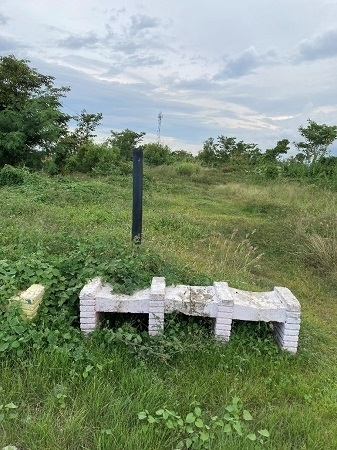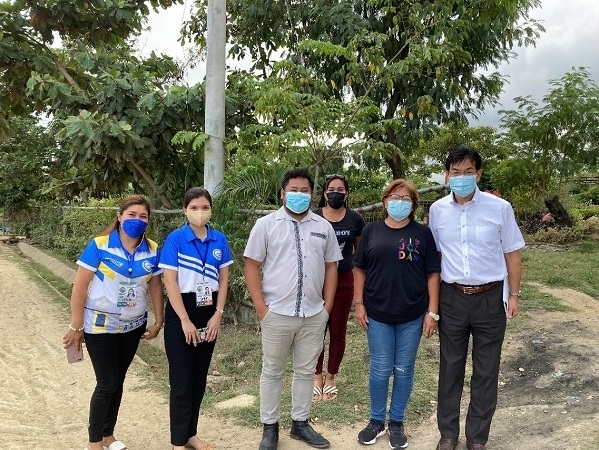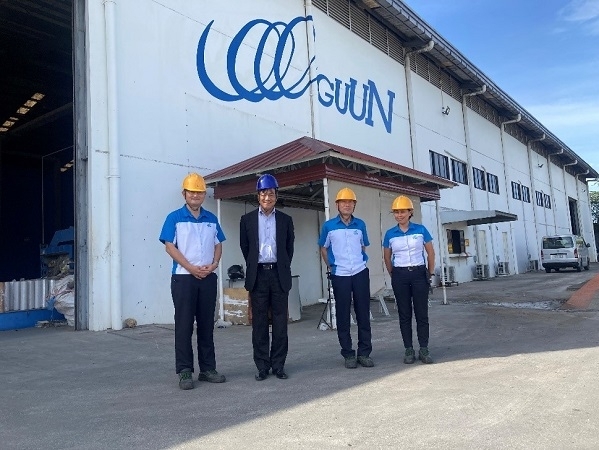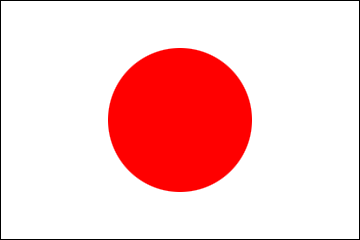Letter from Cebu (17) ”Solid Waste Management Problems in the Philippines and Waste Plastic Re-cycling Company, GUUN”
2023/4/12
Letter from Cebu (17)
”Solid Waste Management Problems in the Philippines and Waste Plastic Re-cycling Company, GUUN”
”Solid Waste Management Problems in the Philippines and Waste Plastic Re-cycling Company, GUUN”
I have been interested in solid waste management problems in the Philippines since I was in my 20s. My interest started when I watched a TV program in Japan dealing with so called “scavengers”, children of poor families picking through garbage at an open dumping site called “a smoky mountain”. I wished they could live in healthy and hygienic conditions. When I arrive here in Cebu, I was still interested in that issue.
Fortunately, open dumping sites were legally banned several years ago, and have been turned into sanitary landfill sites. I visited the Umapad sanitary landfill site in June 2022, one month after my arrival here.
(Umapad Sanitary Landfill. The black pipe releases Methane gas.)

(Officials of Mandaue City Hall and Department of Environment and Natural Resources, Region 7 Office)


(Officials of Mandaue City Hall and Department of Environment and Natural Resources, Region 7 Office)

Before visiting the site, I met with Mandaue City Mayor, Jonas Cortes and he explained to me, “A sanitary landfill site may not be good for the environment, because it releases methane gas and it may contaminate underground water that eventually goes into the sea. But, environmental conservationist groups in the Philippines are very influential in the Congress, and they oppose incinerating garbage. So, introducing incinerators for solid waste management is very difficult in the Philippines.”
Not long after the visit, I obtained encouraging information. GUUN Co., Ltd. is a waste plastic recycling company located in Consolacion, North of Cebu City. Its head office is based in Yokohama. Its main business line is; production of fluff fuel from waste plastic (fluff fuel has the same calorific value as coal, but produced 17% less CO2 emission.), production of wood chip from biomass fuel and Industrial raw material, and consultation on waste management. GUUN Co., Ltd. inaugurated its commercial plant in Consolacion in July 2017, after doing a feasibility study and a pilot project with the cooperation of JICA and Yokohama City since 2012. Its plant can process about 50 tons to 75 tons of waste plastic per day, which is equivalent to one third of the volume of waste plastic in the Metro Cebu area (220 tons a day). The company has been working with Mandaue City over the last five years. In 2018, only 65% of the garbage carried from Mandaue City was recyclable materials. But this number has increased to 85%, after educating garbage segregation to Barangays, with the help of Mandaue City and Yokohama City. The company’s activities help reduce the volume of garbage in the landfill by 40% to 45%. Recently, Danao City Local Government has contracted with GUUN to help in the city’s waste management. I am proud of the company as it contributes to reducing the garbage in the landfill, and improving regional and global environment.
Not long after the visit, I obtained encouraging information. GUUN Co., Ltd. is a waste plastic recycling company located in Consolacion, North of Cebu City. Its head office is based in Yokohama. Its main business line is; production of fluff fuel from waste plastic (fluff fuel has the same calorific value as coal, but produced 17% less CO2 emission.), production of wood chip from biomass fuel and Industrial raw material, and consultation on waste management. GUUN Co., Ltd. inaugurated its commercial plant in Consolacion in July 2017, after doing a feasibility study and a pilot project with the cooperation of JICA and Yokohama City since 2012. Its plant can process about 50 tons to 75 tons of waste plastic per day, which is equivalent to one third of the volume of waste plastic in the Metro Cebu area (220 tons a day). The company has been working with Mandaue City over the last five years. In 2018, only 65% of the garbage carried from Mandaue City was recyclable materials. But this number has increased to 85%, after educating garbage segregation to Barangays, with the help of Mandaue City and Yokohama City. The company’s activities help reduce the volume of garbage in the landfill by 40% to 45%. Recently, Danao City Local Government has contracted with GUUN to help in the city’s waste management. I am proud of the company as it contributes to reducing the garbage in the landfill, and improving regional and global environment.
(Mr. Takeshi Konishi and Mr. Hiroshi Haraki, GUUN Co., Ltd.)

I hope that recycling activities like GUUN would spread throughout the country. But, of course, what one private company can do is very different from what a nation can do. In my observation so far, I cannot be optimistic about the future of waste management in the Philippines. It may be difficult to introduce incinerators to reduce the volume of garbage by one tenth like Japan, to implement 3R (Reduce, Reuse, Recycle) in an appropriate manner, and to create a recycle-oriented society.
The first reason is the power of environmental conservationist groups that oppose the introduction of incinerators. I have talked with some of them. They were adamant that “There is no doubt that incinerators produce dioxin and other harmful emissions. There is a data to support it.” In the case of Japan, Act on Special Measures against Dioxins was enacted in 1999, and, then, various technology for reducing dioxins was developed. As a result, the volume of Dioxins released from incinerators in 2011 reduced by 99% compared to that in 1997. When conservationists use the 1997 data to support their claim, they can easily claim that “incinerators produce dioxins.”
The second reason is environmental related laws that help supporting the conservationists’ claims. There are three important laws in the Philippines, Clean Air Act 1999, Ecological Solid Waste Management Act 2001 and Extended Producer Responsibility Act 2022. Clean Air Act was interpreted to have banned incinerating garbage. The Supreme Court ruled in January 2002 that Clean Air Act “does not absolutely prohibit incineration as a mode of waste disposal; rather, only those burning processes which emit poisonous and toxic fumes are banned.” Although a revised act in line with this ruling was proposed to the Congress in 2013, it was rejected due to a number of opposition.
Ecological Solid Waste Management Act 2001 is based on an assumption that 3R (Reduce, Reuse, Recycle) will be implemented perfectly. Environmental conservationists claim that this law justifies their claim of no incineration. If perfectly implemented, the law ensures that no waste would be generated. But, they neglect an important factor, how many people would cooperate on 3R. The reality is that people in the Philippines generate 16 million tons of waste each year, and most of them are dumped into 900 dumping sites throughout the country, despite the law.
These two laws and Extended Producer Responsibility Act 2022 do not specify the responsibilities and duties of residents and consumers. This marks a stark contrast to environmental laws in Japan. For example, the containers and packaging recycling law in Japan (enacted in 1995) was based on the notion of extended producer responsibility. This law, nevertheless, specifies the roles of consumers (waste segregation), local governments (segregated waste collection) and private companies (recycling). According to the law, these three players should work together to promote the containers and packaging recycling. On the other hand, Extended Producer Responsibility Act 2022 focuses only on private companies’ responsibility. Penalty is imposed only on the private companies. The Government has a target of letting private companies to restore up to 80% of the plastic containers and packaging they sold. But, it may result in imposing excessive burden only on private companies, while no responsibility on consumers and local governments.
The third reason why I cannot be optimistic about the waste management of this country is the trend of Devolution, as I mentioned in my article of Letter from Cebu (16). Constructing and operating waste incinerators requires highly specialized knowledge and experience. We need technocrats, and they usually work in the central government. It seems unwise not to use their expertise and, rather, let them change to other departments in the name of Devolution.
Incinerators also require a lot of money in a short period of time. So, subsidies from the central government are essential. In Japan, the volume of waste management using incinerators increased from 110,000 tons in 1975 to 200,000 tons in 2000. During this period, central government subsidies increased from 22 billion yen to 160 billion yen.
There are several “waste to energy” projects going on at a local government level. These project may not go smoothly, and rather ended up with a failure, without the expertise of technocrats, and close monitoring and financial support from the central government.
I am not in a position to criticize the Philippine Government policy. The Philippines may have its own way to manage the waste. But, when the present waste management is no longer effective despite huge spending of tax payers’ money, I think it is better to give greater focus on the responsibilities of the national government and the duties of residents and consumers.
The Japanese Government has been assisting the Philippines in the waste management area with a number of projects and technical cooperation. I think that Japan should pay more attention on the basic design of the waste management of the Philippines.
The first reason is the power of environmental conservationist groups that oppose the introduction of incinerators. I have talked with some of them. They were adamant that “There is no doubt that incinerators produce dioxin and other harmful emissions. There is a data to support it.” In the case of Japan, Act on Special Measures against Dioxins was enacted in 1999, and, then, various technology for reducing dioxins was developed. As a result, the volume of Dioxins released from incinerators in 2011 reduced by 99% compared to that in 1997. When conservationists use the 1997 data to support their claim, they can easily claim that “incinerators produce dioxins.”
The second reason is environmental related laws that help supporting the conservationists’ claims. There are three important laws in the Philippines, Clean Air Act 1999, Ecological Solid Waste Management Act 2001 and Extended Producer Responsibility Act 2022. Clean Air Act was interpreted to have banned incinerating garbage. The Supreme Court ruled in January 2002 that Clean Air Act “does not absolutely prohibit incineration as a mode of waste disposal; rather, only those burning processes which emit poisonous and toxic fumes are banned.” Although a revised act in line with this ruling was proposed to the Congress in 2013, it was rejected due to a number of opposition.
Ecological Solid Waste Management Act 2001 is based on an assumption that 3R (Reduce, Reuse, Recycle) will be implemented perfectly. Environmental conservationists claim that this law justifies their claim of no incineration. If perfectly implemented, the law ensures that no waste would be generated. But, they neglect an important factor, how many people would cooperate on 3R. The reality is that people in the Philippines generate 16 million tons of waste each year, and most of them are dumped into 900 dumping sites throughout the country, despite the law.
These two laws and Extended Producer Responsibility Act 2022 do not specify the responsibilities and duties of residents and consumers. This marks a stark contrast to environmental laws in Japan. For example, the containers and packaging recycling law in Japan (enacted in 1995) was based on the notion of extended producer responsibility. This law, nevertheless, specifies the roles of consumers (waste segregation), local governments (segregated waste collection) and private companies (recycling). According to the law, these three players should work together to promote the containers and packaging recycling. On the other hand, Extended Producer Responsibility Act 2022 focuses only on private companies’ responsibility. Penalty is imposed only on the private companies. The Government has a target of letting private companies to restore up to 80% of the plastic containers and packaging they sold. But, it may result in imposing excessive burden only on private companies, while no responsibility on consumers and local governments.
The third reason why I cannot be optimistic about the waste management of this country is the trend of Devolution, as I mentioned in my article of Letter from Cebu (16). Constructing and operating waste incinerators requires highly specialized knowledge and experience. We need technocrats, and they usually work in the central government. It seems unwise not to use their expertise and, rather, let them change to other departments in the name of Devolution.
Incinerators also require a lot of money in a short period of time. So, subsidies from the central government are essential. In Japan, the volume of waste management using incinerators increased from 110,000 tons in 1975 to 200,000 tons in 2000. During this period, central government subsidies increased from 22 billion yen to 160 billion yen.
There are several “waste to energy” projects going on at a local government level. These project may not go smoothly, and rather ended up with a failure, without the expertise of technocrats, and close monitoring and financial support from the central government.
I am not in a position to criticize the Philippine Government policy. The Philippines may have its own way to manage the waste. But, when the present waste management is no longer effective despite huge spending of tax payers’ money, I think it is better to give greater focus on the responsibilities of the national government and the duties of residents and consumers.
The Japanese Government has been assisting the Philippines in the waste management area with a number of projects and technical cooperation. I think that Japan should pay more attention on the basic design of the waste management of the Philippines.
Hideki YAMAJI
Consul General of Japan in Cebu
(References)
“Japan’s Waste Management – History and Current Status”, February 2014 Japan’s Ministry of Environment
https://www.env.go.jp/recycle/circul/venous_industry/ja/history.pdf
Philippines Clean Air Act of 1999, RA8479
https://emb.gov.ph/wp-content/uploads/2015/09/RA-8749.pdf
Philippines Ecological Solid Waste Management Act 2001, RA9003
https://www.officialgazette.gov.ph/2001/01/26/republic-act-no-9003-s-2001/
Philippines Extended Producer Responsibility Act of 2022, RA11898
https://lawphil.net/statutes/repacts/ra2022/ra_11898_2022.html
Philippines Supreme Court Ruling G.R. No.147465 (Metropolitan Manila Development Authority, petitioner, vs. Jancom Environmental Corporation and Jancom International Development Projects Pty. Ltd. Of Australia, respondents)
https://www.chanrobles.com/scresolutions/resolutions/2002/april/147465.php
“Japan’s Waste Management – History and Current Status”, February 2014 Japan’s Ministry of Environment
https://www.env.go.jp/recycle/circul/venous_industry/ja/history.pdf
Philippines Clean Air Act of 1999, RA8479
https://emb.gov.ph/wp-content/uploads/2015/09/RA-8749.pdf
Philippines Ecological Solid Waste Management Act 2001, RA9003
https://www.officialgazette.gov.ph/2001/01/26/republic-act-no-9003-s-2001/
Philippines Extended Producer Responsibility Act of 2022, RA11898
https://lawphil.net/statutes/repacts/ra2022/ra_11898_2022.html
Philippines Supreme Court Ruling G.R. No.147465 (Metropolitan Manila Development Authority, petitioner, vs. Jancom Environmental Corporation and Jancom International Development Projects Pty. Ltd. Of Australia, respondents)
https://www.chanrobles.com/scresolutions/resolutions/2002/april/147465.php
(end)
